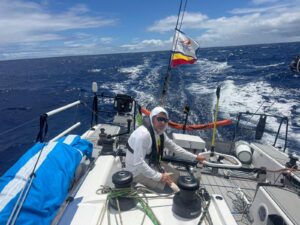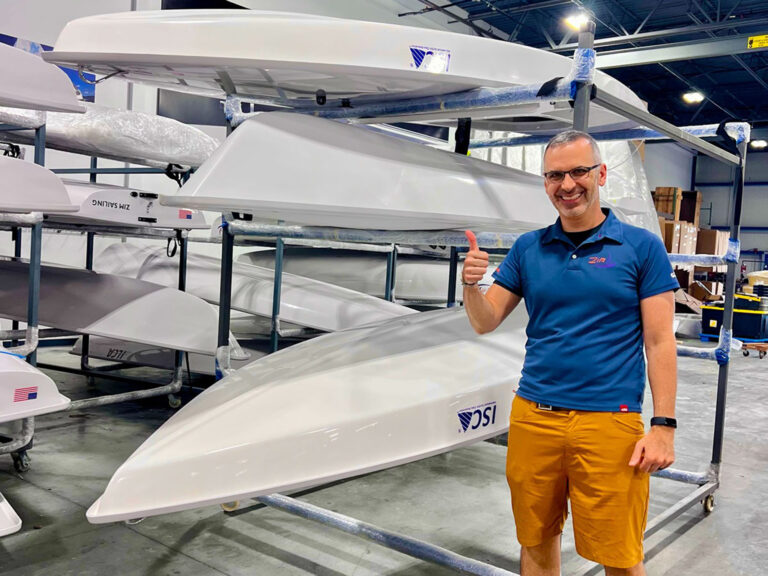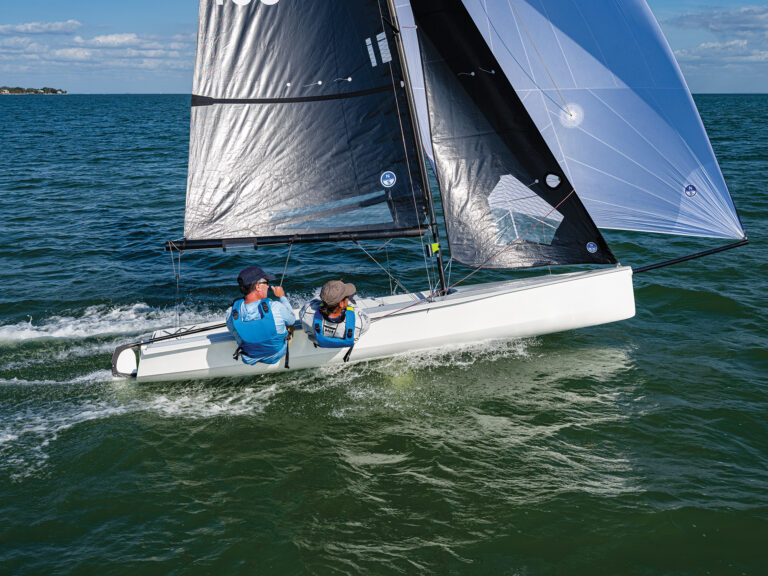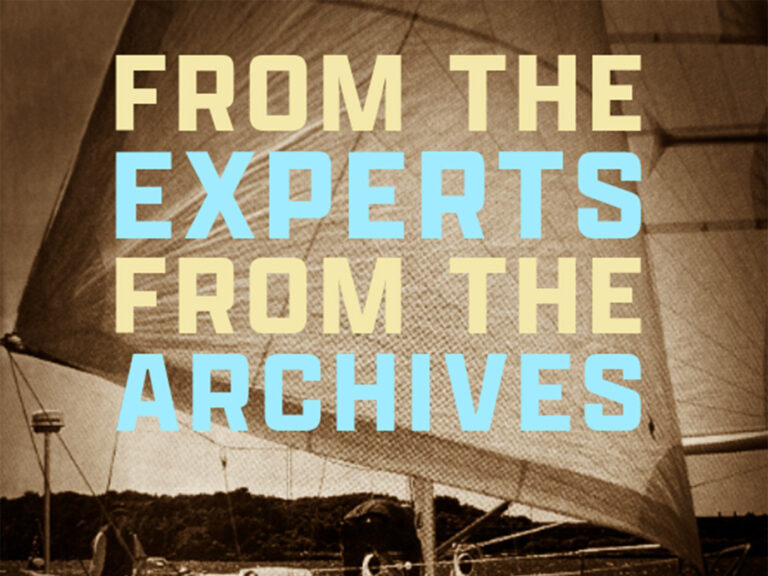
Artemis vs Oracle
For America’s Cup challenger Artemis Racing, Monday, Feb. 11, appeared to be a day to forget. In one of the team’s first opportunities to see how its AC72 stacked up against the competition Artemis Racing got shellacked. Upwind, downwind, reaching: If there was a point of sail on which the Swedish syndicate’s boat was equal to that of Oracle Team USA, they could not find it.
But helmsman Loïck Peyron, buoyed by the perspective gained from years of racing through the most inhospitable, unforgiving oceans on the planet, saw the drubbing in a much different light. The following morning, with a long day of meetings ahead, Peyron was upbeat.
“The good thing is we’ve learned a lot,” he said. “We’ve learned we have a lot to do. It was just a bit more than expected, the difference between the two boats.”
This particular day of reckoning had dawned quietly. With a high pressure system camped off the coast of Northern California, February featured a lot of spectacular winter weather. That Monday was no exception: bright sun and temperatures into the 60s. Both teams towed out from their respective bases—Oracle Team USA has its headquarters on Pier 80 on the southern edge of San Francisco, while Artemis operates out of Alameda, across the bay—into a light northwesterly breeze that promptly evaporated once the teams got within shouting distance.
But there wasn’t much time to lament the lack of wind. A 15-knot sea breeze marched in from the Pacific around 1:30 p.m. and soon thereafter the two teams started an extended sparring session that saw the 72-footers utilizing nearly all of the main basin of San Francisco Bay—with downwind boatspeeds touching close to 30 knots, even that spacious bay can seem claustrophobic.
On the first run it was apparent that Oracle had solved some of the key issues that plagued 17—as the team’s AC72 is known—back in October, before the capsize shelved the big-boat sailing program for four months. Torsional stability issues highlighted by the flexing of the windward hull—“racking,” in America’s Cup parlance—were long gone. And skipper James Spithill’s ability to keep the boat comfortably foiling was markedly improved.
When 17 was in the air, the advantage over Artemis was distinct, with Spithill sailing lower and at a similar speed downwind. As the breeze increased slightly, and Oracle was able to foil for longer stretches, the disparity grew.
The image of Oracle sailing with its hull three feet clear of the water while Artemis remained stuck to the surface was a telling snapshot. But the most impressive display from the defender came upwind. On one long port tack, Oracle started approximately 200 yards to leeward and in front of the challenger and, without sacrificing any speed, effortlessly crabbed to windward until nearly on Artemis’s line. Then Spithill equalized his heading and jetted away.
Later, in Oracle’s cavernous compound on Pier 80, general manager Grant Simmer didn’t bother to disguise his team’s satisfaction with their performance.
“It’s early days, and we’re only just getting into lining up,” said Simmer, who’s America’s Cup experience dates back to being a navigator on Australia II. “But in general we were happy with our performance. We’ve only just got this boat back on the water, we’ve got a whole lot of things lined up that we’re going to test and work on. But we’re excited by our progress since we started—re-started—sailing one week ago.”
A lot of the attention on the AC72s to date has focused on the foils—and their ability to lift the boat out of the water. Most everyone agrees that winning the America’s Cup will require a boat that foils downwind in typical San Francisco Bay summer conditions—15 to 25 knots. This is an area Artemis must explore with its second boat, if not sooner. Peyron, however, focused his disappointment on the team’s wing.
“We’re set with an engine that is not working very well,” said Peyron. “It’s not efficient enough for sure. We know the gap that we have to fill is quite big.”
If this is the case, Artemis could be in a difficult spot. The wing they sailed with that day is the team’s second wing. Their first was unveiled off Valencia, Spain, in the early spring of 2012 and fell to the deck in pieces two months later. It has been repaired and was resting comfortably in the shed when the team went sailing in early February. That first wing employed a three-element arrangement, which should provide superior power downwind. But it’s also a more complex structure.
Artemis’s second wing utilizes a more straightforward two-element design, with the rear element separated into six flaps. Noticeable on this wing is that the upper flaps are distinct from one another, creating a stepped look to any twist in the top half of the sail. Other teams have favored a cohesive leech; with the wing frames and Clysar shrink wrap flexing to accommodate the difference in angle between each hinge.
If Wing 2 isn’t efficient enough and Wing 1 too complex and too fragile—something Artemis Racing tactician Iain Percy hinted at during an interview on Feb. 13—then the team only has one more opportunity to find the correct design for its power plant. The protocol for the 34th America’s Cup limits each team to three wings.
Artemis’s boat is also unique. Juan Kouyoiumdjian and his design team placed a grinding station in the middle of the aft beam, while the other teams have put all the pedestals on either hull. And while Oracle Team USA’s first boat initially came with a tiller, the team switched to a wheel during the post-capsize refit, leaving Artemis Racing as the only team using a tiller.
It’s no surprise to see Artemis looking in every corner of the rule for an edge. Kouyoumdjian is sailing’s most famous maverick, with many great successes and equally spectacular failures on his résumé. Nonetheless, in the days following that first serious sparring session, Percy, who’s taken over leadership of the Artemis sailing team in the wake of Terry Hutchinson’s dismissal, appeared to be drinking from the same half-full glass as Peyron.
“It’s amazing to be out there with two boats, you learn heaps,” said the double Olympic gold medalist. “We all know what one-boat sailing is like, it’s impossible. You can go out, think you’re making improvements, and suddenly there’s another boat there, and it’s huge.”
But he couldn’t quite bring himself to say the team was on the right path, pausing after the word “right” before re-starting: “We’re on a path, we’ve got a good relationship with Oracle, we get on well, we like racing together, and we’re going to enjoy the next few months.”
Or maybe not. A few more training sessions with the defender apparently only reinforced what was learned on that fateful Monday. On Feb. 22, Artemis announced it was suspending its training program and bringing the boat into the shed for modifications.
For both Artemis and Oracle Team USA, this is an unfortunate turn of events. While the Swedish challenger is modifying its boat—and Emirates Team New Zealand and Luna Rossa are training together in New Zealand—the defender will be back to one-boat testing on San Francisco Bay. It’s not as fruitless as with a monohull; having two hulls enables teams to compare different foils and trimming techniques tack-to-tack. In fact, when lining up with Artemis, Oracle was doing just that, with two significantly different daggerboards. But one-boat testing is still not as effective as a solid two-boat testing program. And it’s impossible to do any racing practice.
In-house two-boat testing is part of Oracle’s plan for later this spring and into the summer. But that won’t be easy.
“One thing we have learned is it will be a real challenge to sail two of the boats together within one team,” said Simmer. “[Feb. 11] was the first night we stayed on the mooring; that’s a big deal. If we can leave one boat on the mooring, the days will be much more efficient.”
But for now the team is pleased to have surmounted what could’ve been a crippling failure when the boat capsized and the team’s first wing was completely destroyed. That the design and build crews were able to modify the boat while repairing it may prove to be one of the key moments of this America’s Cup.
For Artemis to rebound, the answer may be in steering back toward the other teams in terms of design philosophy. Wing 2, said Percy, is more conservative than the team’s first one. While it doesn’t yet appear to be fast enough, it is still standing. And the team’s second boat, according to Peyron, will be more “conventional” than the first. The team will also be able to incorporate much of what it has learned through its research of the designs of the other three teams. Unlike in previous America’s Cups, where the key hydro components were perpetually shrouded from view, the nature of the catamaran makes it all but impossible to hide anything substantial. And if they need a reminder about the ability to turn a negative into a positive, Artemis need only look across the Bay.









